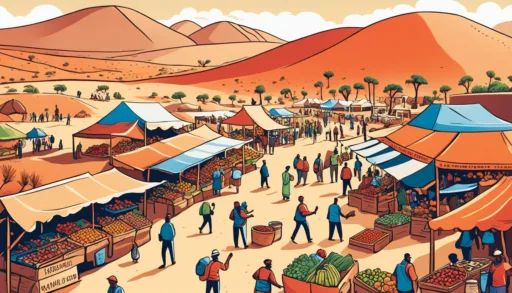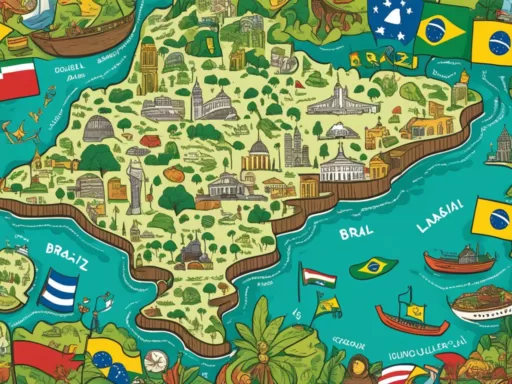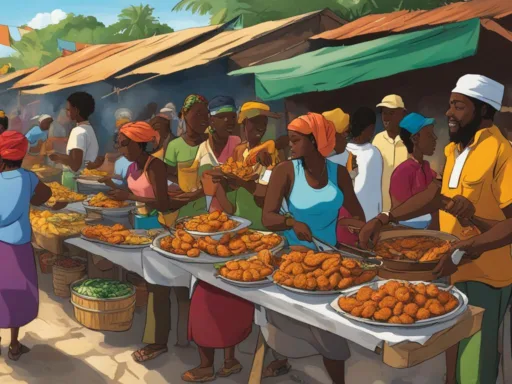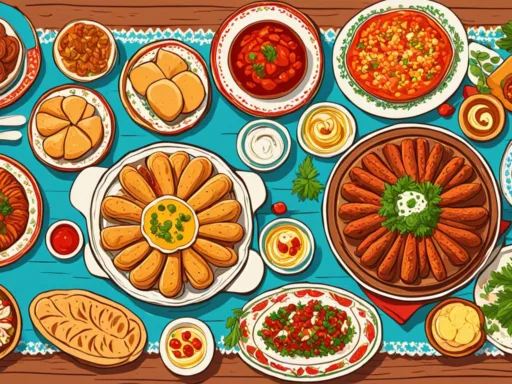Whisper the term ‘gourmet paradise’ and minds often wander to the cobbled streets of Paris or the bustling alleyways of Tokyo. But what if there’s an uncharted culinary treasure nestled along the untamed Atlantic coast of Africa? This is where authentic Namibian cuisine steps in, holding a cornucopia of tastes and traditions ready to rewrite the narrative of your palate. In this Namibian Cuisine Guide, we commence a sensory adventure that transcends the mere consumption of food to celebrate the spirit of a nation.
Traditional Namibian recipes are more than just sustenance; they’re a fusion of cultures, an aromatic parade that tells tales of native tribes, wanderers, and colonizers. As you delve into the intricacies of Namibian culinary culture, discover how a seemingly quiet country on the world’s gastronomic stage dances to the beat of diverse flavors, crafting its own epicurean identity. From the hearths of local homes to the flames of open-air markets, every morsel of authentic Namibian cuisine is a journey through time and taste.
Key Takeaways
- The rich heritage of Namibian culinary arts celebrates the nation’s history and indigenous influences.
- Exploring traditional Namibian recipes offers a sensory journey into the country’s diverse dishes.
- Namibian cuisine represents a vibrant fusion of past and present culinary practices, symbolizing unity and cultural exchange.
- Each Namibian dish tells its own story, reflecting the connection of the people to their land and history.
- A traveler’s guide to Namibia’s gastronomy invites diners to experience meals that are as much about community as they are about flavor.
The Cultural Mosaic of Namibian Gastronomy
The vibrant palette of Namibian food dishes is deeply interwoven with the country’s storied past, making Namibian cuisine history an essential ingredient in its cultural fabric. As various communities have imprinted their identities onto the national foodscape, we find a truly unique gastronomic experience awaiting those keen to explore the flavors of Namibia.
Indigenous Herero Influences on Meat Dishes
The Herero community, with its nomadic heritage, has profoundly influenced the preparation of meats in Namibia. Techniques passed down through generations reflect not only a mastery of skills necessary for survival but also a deep-seated respect for the livestock that roam the land.
Ovambo Inspirations: Aromatic Stews and Flavors
Contributions from the Ovambo people, the largest ethnic group in Namibia, are evident in the aromatic herbs and spices that characterize many popular Namibian dishes. The flavorsome stews and gravies often feature ingredients endemic to the region, climaxing in a kaleidoscope of scents and tastes.
The Colonial Imprint on Modern Namibian Cuisine
European settlers left an indelible mark on what is now considered contemporary Namibian cuisine. A fusion of external cooking techniques with local delicacies has yielded a culinary landscape that’s both innovative and nostalgic, seamlessly blending the best of both worlds.
Here’s a brief overview of the staples that epitomize Namibian gastronomy:
| Dish | Origin | Key Ingredients | Description |
|---|---|---|---|
| Braaivleis | Herero | Meat, spices | Grilled meat showcasing traditional barbecuing methods. |
| Oshithima | Ovambo | Mahangu (pearl millet), water | A dense porridge served with stews and sauces. |
| Kapana | Street food influence | Various meats, chili, spices | Cuts of meat grilled to perfection and seasoned on demand. |
| Potjiekos | Colonial influence | Meat, vegetables, spices | Slow-cooked stew, a culinary heirloom from settlers. |
Namibian Cuisine Guide: From Biltong to Wild Game
Embark on a gastronomic journey through the landscapes of flavors and traditions with our Namibian cuisine guide. Encountering a world of robust Namibian food dishes, each plate offers an echo of the country’s diverse culinary narratives. Famed for its rich, air-dried biltong and an array of wild game offerings, this is a foray into the authentic and traditional Namibian recipes that mark Namibia’s heritage and identity.
Biltong, a mainstay in Namibian cuisine, is celebrated for its savory taste and lengthy preservation method. Traditionally made from beef or game meat such as kudu, it is marinated in a blend of spices before it undergoes the process of air drying. A testament to Namibia’s ingenuity in conservation, biltong is an ideal high-protein snack for the locals and a must-try for visitors.
Alongside biltong, the Namibian culinary culture takes pride in its wild game cuisine. Known for an ethical and sustainable approach to hunting, Namibian chefs craft dishes from venison that not only tantalize the taste buds but also honor ancient hunting practices. Here, one can indulge in delightful meals that range from springbok steaks to oryx stews – all incredibly flavorful and tender.
- Springbok Fillet – A delicacy that brings out the subtle game flavors, often served grilled or roasted with indigenous spices.
- Oryx Stew – A warmer, heartier dish that personifies traditional cooking methods, slow-cooked to perfection with a blend of local herbs.
- Warthog Ribs – Known for their rich taste, these ribs are commonly barbecued and enjoyed as a finger-licking feast.
| Wild Game Dish | Characteristic Flavor | Traditional Cooking Method |
|---|---|---|
| Springbok Fillet | Lean and subtly gamey | Grilled or roasted with a crust of local spices |
| Oryx Stew | Savory with harmonizing spice undertones | Slow-cooked in a pot with aromatic herbs |
| Warthog Ribs | Rich and succulent | Barbecued over an open flame |
Diving into the traditional Namibian recipes reveals more than tantalizing tastes; it provides a narrative of the nation’s history, its relation with the land, and its wildlife. Indeed, Namibian dishes are a culmination of the culture’s reverence for its environment, emphasizing sustainability and celebrating communal dining experiences.

Dining in Namibia offers more than a meal; it’s an intimate taste of its history, an opportunity to understand its values and partake in the essence of Namibian culinary culture – a culture steeped in the flavors of vast wild landscapes and tales of ancestry.
Preservation and Innovation: The Art of Namibian Biltong and Droëwors
The traditional Namibian recipes that have stood the test of time are a testament to the enduring nature of Namibian culinary culture. Among these, biltong and Droëwors stand out as iconic Namibian food dishes combining preservation practices with the innovative spirit of the nation’s people.
Mastering the Biltong Technique
Biltong is more than just a preserved meat; it is a cultural icon of Namibia. A result of careful technique, it is made from various meats including game and beef. The process involves an intricate marination and air-drying method that has been perfected over generations, resulting in a distinctive flavor and texture embraced by locals and food enthusiasts alike.
Discovering Droëwors: A Sausage Delight
Droëwors, a type of dried sausage, are equally prized in Namibia for their rich flavor profile, achieved through a unique blend of spices and traditional drying methods. These savory snacks emphasize the Namibian knack for creating sumptuous dishes that can be enjoyed over time.
| Biltong | Droëwors |
|---|---|
| Typically made from game or beef | Made from minced meat, commonly beef |
| Unique marination process | Seasoned with a variety of spices |
| Air-dried preservation method | Traditionally air-dried |
| Often eaten as a snack | Popular as a snack or appetizer |
| Symbolizes Namibia’s history of survival | Reflects Namibian culinary innovation |
As beloved components of Namibian culinary culture, biltong and Droëwors connect the past with the present, offering a delicious way to experience the country’s culinary heritage. Both are sought after not only for their taste but for their role in sharing the Namibian story with every bite.
The Social Heart of Namibia: Communal Potjiekos
Namibian culinary culture is revealed in the communal act of preparing and sharing Potjiekos, a traditional stew that serves as the social heart of Namibian food dishes. Central to family gatherings and local festivals, Potjiekos is not simply a meal but a cultural symbol representing the unity and collaborative spirit of the people. Best Namibian restaurants have been known to serve this homely dish, providing a warm and authentic taste of the nation’s communal dining experience.

Over an open fire, the contents of the pot meld together, each ingredient carefully chosen to reflect the land’s bounty and the stories of its inhabitants. Below is a table illustrating the fundamental components of a traditional Potjiekos meal and their significance within Namibian society.
| Ingredient | Cultural Significance | Common Ingredients in Namibian Potjiekos |
|---|---|---|
| Meat | Represents the pastoral lifestyle and the respect for livestock. | Beef, Lamb, Goat, and Game |
| Vegetables | Symbolizes the fertility of the Namibian land and the sustenance it provides. | Potatoes, Carrots, and Cabbage |
| Spices | Reflects the blend of cultures and the historical trade routes that influenced Namibian cuisine. | Coriander, Cumin, and Nutmeg |
| Grains | Echoes the importance of agriculture in communal living and social cohesion. | Rice or Pearl Millet |
| Herbs | Indicative of local foraging and the use of indigenous knowledge in cooking. | Bay Leaves and Wild Rosemary |
Potjiekos exemplifies a tradition where cooking and eating become an act that weaves individuals into the broader narrative of Namibian history. The act of sharing this slow-cooked stew comes loaded with anticipation and satisfaction, mirroring the essence of Namibian hospitality and the close-knit feel of its communities. Whether enjoyed at a family home or one of the best Namibian restaurants, a plate of Potjiekos is a plate of togetherness, shared stories, and celebrated heritage.
The Streets Come Alive with Kapana: Namibia’s Street Food Treasure
In the heart of Namibia’s bustling markets, the essence of street cuisine takes the form of Kapana, a dish deeply rooted in the nation’s urban culture. This popular Namibian dish has become a staple at local markets and roadside stands, where the sizzle of grilling meat forms the soundtrack to city life. Not just a quick meal, Kapana is a culinary event that engages all the senses, cementing its status as one of the most authentic Namibian food dishes available.
Kapana Variations: An Array of Meats and Spices
Kapana is not simply one dish, but rather a symphony of options tailored to the tastes of each individual. Patrons can choose from a variety of meats, including beef, lamb, and occasionally game, each imparting its own unique flavor to the iconic dish. The meats are customarily seasoned with a mix of spices that often reflect the rich palette of authentic Namibian cuisine, with combinations that tickle the taste buds and leave a lasting impression on the palate.
Street Vendors: The Pioneers of Kapana
The true artists behind Kapana are the street vendors, who meticulously grill the meat to perfection. Often marinated for hours, the meat is cooked over open flames, with vendors fanning the coals to produce the perfect char. These culinary entrepreneurs are a testament to Namibian ingenuity, transforming simple ingredients into one of the most sought-after popular Namibian dishes in the urban gastronomic scene.
Visitors and locals alike gravitate towards these aromatic stalls, where the experience of Kapana extends beyond consumption; it’s an opportunity for community connection, cultural exchange, and participating in a tradition that stays alive with each bite. Kapana is not just food; it’s the flavor of Namibia’s streets and the heart of its people.
Namibia’s Bush Delicacy: The Mopane Worm Experience
Foraging through Namibia’s natural pantry uncovers the intriguing Mopane worm, an essential feature of Namibian food dishes that has sustained generations and is ingrained in Namibian culinary culture. These caterpillars, when transformed into a crunchy or smoked delicacy, illustrate the ingenuity of traditional Namibian recipes. By integrating these creatures into their diet, Namibians continue to navigate the delicate balance of utilizing available resources without detriment to their environment.

Mopane worms are not only a rich source of protein but also a canvas for a variety of spices and cooking techniques that bring out their unique flavor. Appreciating this unconventional food choice affords a deeper understanding of Namibia’s gastronomic diversity and environmental harmony.
| Preparation Method | Description | Nutritional Value |
|---|---|---|
| Fried Mopane Worms | Caterpillars fried to a crisp, often seasoned with salt and chili. | High in protein, low in fat. |
| Smoked Mopane Worms | Gently smoked over an open fire, absorbing the rich woodsy flavors. | Retains nutrients and vitamins through smoking process. |
| Dried Mopane Worms | Sun-dried for preservation, can be rehydrated and cooked in stews. | Concentrated source of protein, iron, and potassium. |
While Mopane worms may be a novel item on the plates of visitors, they are a time-honored snack for locals, casting light on the resilience of both the people and the worm as a species. Embracing the Mopane worm is to experience a true taste of Namibia’s resourcefulness and tradition.
Grains of Tradition: the Role of Mahangu in Namibian Cuisine
Delving into the rich tapestry of the nation’s gastronomy, it’s impossible to overlook the fundamental impact of Mahangu (pearl millet) on traditional Namibian recipes. A steadfast crop that weathers the arid climates of Namibia, Mahangu is not only the backbone of many rustic dishes but also a poignant symbol of economic sustenance and cultural resilience.
Mahangu in Namibian Cuisine: A Staple Food
Integral to the daily diet of vast communities, Mahangu presents itself as a versatile foundation to countless Namibian food dishes. Proving its significance, best Namibian restaurants frequently include this staple in their menus, whether grounded into flour or cooked whole. The grain’s cultural importance echoes with every serving, celebrating the country’s agrarian legacy.
Culinary Uses and Dishes Featuring Mahangu
Namibian cuisine celebrates Mahangu in various incarnations, including the popular Oshifima or porridge-like Mahangu pap, which pairs beautifully with robust meat stews. These culinary creations reflect the Namibian tradition of communal eating, offering a taste that resonates with the soul of the land and its people. It’s a testament to the grain’s role in perpetuating traditional ways of life in the dishes that grace tables across the region.
The resilience of Mahangu crops under tough environmental conditions mirrors the strength and determination of the Namibian people to maintain their culinary heritage through generations. The grain’s flexibility in various dishes is a culinary celebration of its integral role in the nation’s food narrative—a story of sustenance and community that continues to shape the identity of Namibia.
Namibian Food Dishes: A Flavorful Encounter
An exploration of Namibian food dishes is akin to embarking on a culinary odyssey, rich with flavors that celebrate the country’s wide-ranging cultural influences and innovative spirit. The Namibian Cuisine Guide is designed to introduce food enthusiasts to the unique and savory journey experienced through popular Namibian dishes. Let us guide you through taste and tradition as you discover the essence of Namibia’s heart through its food.
From the tender, game-infused specialty dishes derived from the vast wilderness to the bustling energy of street food markets, each dish offers an authentic taste of local customs. Below is a snapshot of some of the delectable offerings you’ll find in Namibia’s culinary scene, which artfully combines tradition with the creative flair of contemporary preparation.
| Traditional Game Dish | Street Food Highlight | Communal Feast |
|---|---|---|
| Oryx steak, marinated in indigenous spices before being grilled over an open flame | Kapana, a variety of flame-grilled meats, cut into bite-sized pieces and seasoned to perfection | Traditional Potjiekos, a slow-cooked stew filled with meats and vegetables enjoyed around a shared pot |
| Springbok tenderloin, a succulent delight often served with a rich, red wine sauce | Fried Mopane worms, a crunchy snack rich in protein, commonly sold in open-air markets | Grilled fish, seasoned with piquant spices and served alongside staple grains |
These staple dishes serve as more than just sustenance; they are vivid expressions of Namibia’s story. They connect diners with the country’s past and invite them on an unforgettable journey of taste. Whether it’s the species variety in their game meats or the traditional flavors found in their vibrant street food, the culinary offerings of Namibia await those seeking an unrivaled gastronomic experience.
For connoisseurs of distinct cuisines, sampling the popular Namibian dishes is an absolute must. Dive into the heart of this rich culinary landscape with the ultimate Namibian Cuisine Guide, which will surely transform your understanding of flavor, tradition, and innovation.
Authentic Namibian Cuisine: Traditional Recipes and Shared Memories
The essence of Namibia’s culinary heritage is encapsulated in its traditional recipes and the fond memories they evoke. Far beyond mere sustenance, authentic Namibian cuisine is an intimate portrayal of its rich cultural narrative. These ancestral dishes, laced with the spices of history and humanity, are cherished heirlooms within every Namibian home, each bite a testament to the nation’s enduring spirit.
Preserving Namibia’s Culinary Heritage Through Family Recipes
Within the familial hearth, traditional Namibian recipes are sacred texts, transferred from one generation to the next. They are an intrinsic element of Namibia’s social fabric, fostering a culinary continuity that maintains the vibrancy of the nation’s palate. As guardians of this flavorful legacy, families stand firm against the erosion of time, ensuring their culinary traditions remain alive and robust.
Learning from Local Namibian Chefs and Home Cooks
Namibian culinary culture is a living museum, where local chefs and home cooks are the esteemed curators. Through their passion and expertise, they lead a gastronomic renaissance, reinventing and sharing authentic Namibian cuisine in a modern context. The knowledge imparted by these culinary artisans offers a lens through which we can savor and understand the true essence of Namibia’s gastronomic identity.
Amongst the tapestry of flavors that make up Namibian cuisine, certain dishes stand out for their cultural significance and unchanging popularity. The table below offers a glimpse into a selection of these culinary staples, embodying the diversity and richness of Namibia’s food heritage.
| Traditional Dish | Description | Cultural Significance |
|---|---|---|
| Oshifima | A porridge made from pearl millet, often served with stew. | A staple food, symbolizing sustenance and communal dining. |
| Braaivleis | Meat grilled over an open fire, flavored with indigenous spices. | Reflecting Namibia’s love for barbecue and outdoor gatherings. |
| Kapana | Sliced meat grilled to perfection on street corners. | A street food favorite, showcasing the casual side of Namibian cuisine. |
| Potjiekos | Slow-cooked stew made in a cast-iron pot. | Encapsulates the spirit of community and shared meals. |
Through the act of cooking and eating, every Namibian has the opportunity to engage with a heritage that is as flavorsome as it is meaningful. The rhythms of traditional methods, the communal laughter around the fire, and the shared satisfaction of a meal well-made are the bonds that weave the fabric of Namibia’s culinary identity. Embracing these traditions invites us all to taste and uphold the proud legacy of Namibian culinary culture.
Best Namibian Restaurants: A Culinary Adventure
Immerse yourself in the splendor of Namibia’s gastronomy by dining at the best Namibian restaurants. These havens of flavor offer more than just food; they serve as gateways to the rich heritage of Namibian culinary culture, delivering an eating experience that resonates with passionate food enthusiasts and cultural connoisseurs alike. Each restaurant aligns itself with the traditional tastes and innovation that Namibian cuisine proudly presents to the world.
When you refer to a Namibian Cuisine Guidebook, you’ll find a meticulous selection of restaurants that have mastered the art of both classic and contemporary dishes. Expert chefs at these eateries take pride in their ability to innovate while staying true to the authentic roots of Namibian culinary tradition. From the rich, savory tenderness of perfectly seasoned game meat to the fresh, bold flavors of ocean-caught fish, each menu item is a testament to Namibia’s diverse and vibrant food scene.
Indulging at the pinnacle of Namibia’s food establishments not only satisfies your taste buds but also allows for a cultural sojourn through the country’s edible heritage. The ambiance and hospitality encountered in these venues contribute to the complete sensory adventure, one that is peppered with historical relevance and contemporary flair. Embark on this culinary adventure and genuinely comprehend why Namibian culinary culture is esteemed by global gastronomes and local aficionados alike.
FAQ
What are the key characteristics of Namibian cuisine?
Can you describe the influence of the Herero and Ovambo on Namibian dishes?
What is Biltong, and why is it significant in Namibian cuisine?
How do traditional Namibian recipes differ from modern ones?
What makes Potjiekos a unique Namibian dish?
Why is Kapana considered a must-try street food in Namibia?
What is the significance of Mahangu in Namibian dietary practices?
How do Namibian restaurants contribute to the preservation of its culinary culture?
Are traditional Namibian ingredients used in contemporary cuisine?
How do I find authentic Namibian cuisine?
Source Links
- https://www.flavors-of-the-globe.com/
- https://medium.com/@scribblesandnibbles/part-1-namibian-gastronomy-unveiled-a-historical-and-cultural-odyssey-through-culinary-delights-c292f33b2f01
- https://www.streetbitesworld.com/post/exploring-namibia-s-culinary-delights-a-dive-into-the-rich-history-and-preparation-of-traditional-namibian-recipes-48






